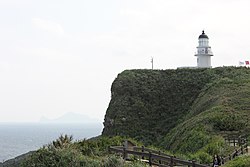Cape Santiago Sāndiāojiǎo | |
|---|---|
 Lighthouse at Cape Santiago | |
| Coordinates: 25°00′27″N122°00′06″E / 25.007431°N 122.001736°E | |
| Location | Gongliao District, New Taipei City, Taiwan |
| Cape Santiago | |||||||||||
|---|---|---|---|---|---|---|---|---|---|---|---|
| Chinese | 三貂角 | ||||||||||
| |||||||||||
Cape Santiago [1] [2] [a] is a cape on the easternmost point of the island of Taiwan,located in the Gongliao District,New Taipei City.

